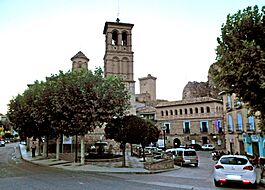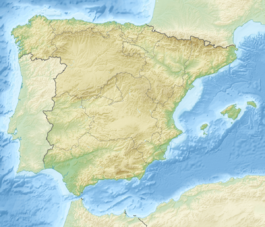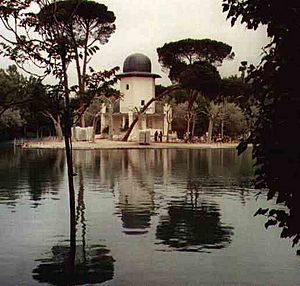Alhama de Aragón facts for kids
Quick facts for kids
Alhama de Aragón
|
|||
|---|---|---|---|

View of Alhama de Aragón
|
|||
|
|||
| Country | |||
| A. community | |||
| Province | |||
| Area | |||
| • Total | 31.14 km2 (12.02 sq mi) | ||
| Population
(January 1, 2021)
|
|||
| • Total | 996 | ||
| • Density | 31.98/km2 (82.8/sq mi) | ||
| Time zone | UTC+01:00 | ||
| Postal code |
50230
|
||
| MCN | 50020 | ||
Alhama de Aragón is a special town in the province of Zaragoza, Aragon, Spain. It's known as a spa town because of its natural hot springs. The town sits by the Jalón River, which flows into the larger Ebro River.
As of 2021, about 996 people live here. The main businesses are the spa hotels, called balnearios, and a factory that makes lights. Farmers in the area grow lots of fruit, and some people also make wine.
You can travel to Alhama de Aragón by train. There are train services to nearby towns like Arcos de Jalón and Calatayud. From Calatayud, you can catch fast AVE trains to big cities like Madrid and Barcelona.
A movie called Los jueves, milagro (Every Thursday a Miracle) was filmed here in 1957. It's about local business people who try to make the spas popular again by pretending a miracle happens every Thursday.
Contents
History of Alhama de Aragón
Alhama de Aragón has been famous for its hot springs for over 2,000 years. The ancient Romans knew about this town. They called it Aquae Bilbilitanorum, which means "waters of Bilbilis," referring to a nearby Roman city.
The town's current name, Alhama, comes from the Arabic word Al-Hammam, meaning "the baths." An Arab fortress here was captured by a famous Spanish hero, El Cid, in 1070. But it went back to Moorish control until King Alfonso I of Aragón took it back in 1122.
For the next 300 years, the rulers of Castille and Aragon often fought over the town. Finally, in 1457, it became a permanent part of Aragon. In the 1800s, people started to use the hot springs more. They built several spa hotels, and four of them are still open and popular today.
During World War II, some Allied soldiers who escaped or crashed near Spain were kept in the town for a time.
Things to See and Do
One amazing place to visit is the unique thermal lake at Balneario Termas Pallarés. It's almost two hectares big and is open all year. The water in the lake stays at a warm 34 °C (93 °F) all the time!
About 25 kilometers southwest of Alhama, you can find the famous Cistercian abbey of Monasterio de Piedra. It has beautiful water gardens to explore. The city of Calatayud is about 35 kilometers northeast. Calatayud is known for its incredible mudéjar church towers. Mudéjar is a special style of art and building that blends Christian and Islamic designs. You can see more examples of this art in other nearby villages too.
Local Festivals (Fiestas)
Alhama de Aragón celebrates several fun festivals throughout the year:
- La Virgen de las Candelas and San Blas: These are celebrated on February 2–3.
- Pilgrimage to San Gregorio: This special walk to the hermitage (a small chapel) of San Gregorio happens on the second Sunday in May.
- Pilgrimage to Santa Quiteria: Another pilgrimage to the hermitage of Santa Quiteria takes place on May 22.
- San Roque: This festival is celebrated from August 14–17.
Famous People from Alhama
- Pablo Luna Carné (1879-1942): A famous composer who wrote zarzuelas, which are Spanish musical plays.
- Ángel Vicioso (1977-): A professional racing cyclist.
Nearby Towns
See also
 In Spanish: Alhama de Aragón para niños
In Spanish: Alhama de Aragón para niños





